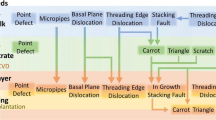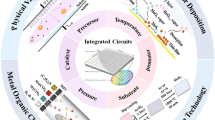Abstract
The new generation of photovoltaic devices require high quality silicon wafer for solar cell fabrication. Minority carrier lifetime is a basic parameter to be considered for the fabrication of silicon-based energy devices. temporarily passivating the surface of solar-grade silicon wafers using an iodine-ethanol solution after a novel cleaning process involving acetone and ethanol in an ultrasonic bath and saw damage removal (SDR). After cleaning process and the saw damage removal, the 0.2 mol/L Iodine-Ethanol (I-E) solution was used for temporary chemical surface passivation to measure the bulk lifetime of the two types of wafers, which was measured to be 802 μs for phosphorus doped n-type wafer and 226 μs for gallium doped p-type wafer. We explored that with these passivation parameters, a Quokka 3 simulation study validates the use of these wafers in TOPCon solar cells, achieving 22.3% efficiency on p-type wafers and 23.3% on n-type c-Si wafers. Our research showcases the potential of cleaning methods and chemical passivation for solar-grade wafers in the production of high-efficiency solar cells.
Similar content being viewed by others
Data Availability
Data available on request from the authors.
References
Ju M, Lee Y, Lee K, Han C, Jo Y, Yi J (2012) Effectiveness of Iodine Termination for Ultrahigh Efficiency Solar Cells as a Means of Chemical Surface Passivation, Jpn J Appl Phys. 51: 09MA03. https://doi.org/10.1143/JJAP.51.09MA03
Andres C, Daniel M (2004) Measuring and interpreting the lifetime of silicon wafers. Sol Energy 76:255–262. https://doi.org/10.1016/j.solener.2003.07.033
Mohammad A, Nicholas E, Grant A, Pointon JD (2019) Iodine-Ethanol Surface Passivation for Measurement of Millisecond Carrier Lifetimes in Silicon Wafers with Different Crystallographic Orientations. Phy Status Solidi A 216:1900257. https://doi.org/10.1002/pssa.201900257
Mattias J, Ned W, Stephen B (2018) Hydrogen Passivation for Estimating the Bulk Lifetime of Bare Silicon Wafers, Phy Status Solidi (RRL) - Rapid Research Letters 12 (6): 1800093. https://doi.org/10.1002/pssr.201800093
Cheng X, Erik S, HalvardHaug CC, Marisa D (2016) Thermal stability of hydrogenated amorphous silicon passivation for p-type crystalline silicon. Phy Status Solidi A 213(1):91–95. https://doi.org/10.1002/pssa.201532679
Dao V, Heo J, Kim Y, Kim K, Lakshminarayan N, Yi J (2010) Optimized surface passivation of n and p type silicon wafers using hydrogenated SiNx layers. J Non-Cryst Solids 356:2880–2883. https://doi.org/10.1016/j.jnoncrysol.2010.09.025
Abdulrahman M (2014) Characterization of Al2O3 surface passivation of silicon solar cells. Thin Solid Films 562:451–455. https://doi.org/10.1016/j.tsf.2014.03.071
Bhumika C, Stuart B, Robert L, Christiana B (2010) High effective minority carrier lifetime on silicon substrates using quinhydrone-methanol passivation. Appl Phys Lett 96:063502. https://doi.org/10.1063/1.3309595
Nicholas E, Keith R, Jason T (2012) Evaluation of the Bulk Lifetime of Silicon Wafers by Immersion in Hydrofluoric Acid and Illumination. ECS J Solid State Sci Technol 1(2):55–61. https://doi.org/10.1149/2.003202jss
James B, Daisuke K, Nicholas G, Angelica A, Mark H, Teng K, Pheng P, Hang C, Di Y, Daniel M, Manuel A, Robert M, Andres C, Ali J (2016) Superacid Passivation of Crystalline Silicon Surfaces. ACS Appl Mater Interfaces 8:24205–24211. https://doi.org/10.1021/acsami.6b07822
Nicholas E, Jhon D (2017) Temporary Surface Passivation for Characterisation of Bulk Defects in Silicon: A Review, Phy Status Solidi (RRL) - Rapid Research Letters 11(11): 1700243. https://doi.org/10.1002/pssr.201700243
Muhammad Q, Hasnain Y, Fan X, Han S, Kim Y, Suresh K, Yi J (2023) A Review on p-Type Tunnel Oxide Passivated Contact (TOPCon) Solar Cell, Transactions on Electrical and Electronic Materials. Trans Electr Electron Mater 24:169–177. https://doi.org/10.1007/s42341-023-00433-z
Muhammad Q, Hasnain Y, Fan X, Han S, Kim Y, Suresh K, Yi J (2023) Application of n-Polysilicon Rear Emitter for High-Efficiency p-TOPCon Solar Cells. Adv Theory Simul 6:2300078. https://doi.org/10.1002/adts.202300078
Sakti P, Paresh K (2023) State-of-the-art passivation strategies of c-Si for photovoltaic applications: A review. Mater Sci Semicond Process 154:107202. https://doi.org/10.1016/j.mssp.2022.107202
Rotem H, Roy S, Omer Y, David C (2013) Molecular field effect passivation: Quinhydrone/methanol treatment of n-Si(100). J Appl Phys 113:084909. https://doi.org/10.1063/1.4793497
Funding
This research was supported by grants from the New and Renewable Energy Technology Development Program of the Korea Institute of Energy Technology Evaluation and Planning (KETEP) funded by the Korean Ministry of Trade, Industry, and Energy (MOTIE) (Project No.20218520010100). This work was also supported by the National Research Foundation of Korea (NRF) grant funded by the Korea Government (MSIT) (No. NRF-2022R1A4A1028702).
Author information
Authors and Affiliations
Contributions
Mengmeng Chu performed the conceptualization, investigation, formal analysis, data curation, write-original draft, visualization. Muhammad Quddamah Khokhar performed writing-review & Editing, Software, formal analysis, and data curation. Fucheng Wang performed investigation. Suresh Kumar Dhungel performed data curation, formal analysis, investigation, and visualization. Junsin Yi contributed for supervision, investigation, visualization, project administration, and fund acquisition.
Corresponding authors
Ethics declarations
The authors declare that they have no known competing financial interests or personal relationships that could have appeared to influence the work reported in this paper.
Competing Interests
The authors declare no competing interests.
Ethics Approval
Not applicable (The results of this study do not involve any human or animal).
Consent to Participate
Consent was obtained from all the authors included in this article.
Consent for Publication
The authors agree to publish.
Additional information
Publisher's Note
Springer Nature remains neutral with regard to jurisdictional claims in published maps and institutional affiliations.
Rights and permissions
Springer Nature or its licensor (e.g. a society or other partner) holds exclusive rights to this article under a publishing agreement with the author(s) or other rightsholder(s); author self-archiving of the accepted manuscript version of this article is solely governed by the terms of such publishing agreement and applicable law.
About this article
Cite this article
Chu, M., Khokhar, M.Q., Wang, F. et al. Improving the Surface Passivation and Cleaning Quality of c-Si Wafers for the Application of TOPCon Solar Cells. Silicon 16, 2245–2252 (2024). https://doi.org/10.1007/s12633-023-02831-7
Received:
Accepted:
Published:
Issue Date:
DOI: https://doi.org/10.1007/s12633-023-02831-7




